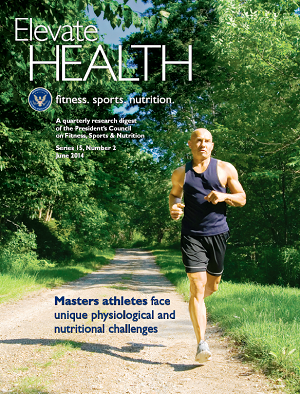Atletas Master
Esportes Competitivos e Nutrição Esportiva para Idosos

Downloads
Palavras-chave:
fitness, esportes, nutrição, mastersResumo
Nesta edição da Elevate Health, Rachel Kelley, BS, e Stella Volpe, PhD, RD, LDN, FACSM, da Drexel University abordam o importante tópico das recomendações nutricionais para adultos mais velhos em esportes competitivos. À medida que aumenta o número de atletas master, esta área temática torna-se cada vez mais importante. Como a Sra. Kelley e o Dr. Volpe descrevem, a nutrição para atletas masters segue muitos dos mesmos princípios de todos os outros adultos; no entanto, existem algumas diferenças importantes. Dependendo do status do peso e da participação atlética, as necessidades de calorias e proteínas podem diferir. Além disso, existem alguns nutrientes de preocupação especial para atletas idosos, como a vitamina D. É importante ressaltar que os atletas idosos correm o risco de doenças crônicas e declínio funcional, assim como todos os idosos. A orientação fornecida neste documento ajudará os praticantes a orientar os atletas master para melhorar a saúde geral e ajudá-los a atingir seu pleno potencial atlético agora e no futuro.
Artigo integrante da Edição Especial NUTRIÇÃO E SUPLEMENTAÇÃO EM NATAÇÃO E ESPORTES AQUÁTICOS
Referências
Foster C, Wright G, Battista RA, Porcari JP (2007). Training in the aging athlete. Current Sports Medicine Reports, 6(3), 200–206.
Anish EJ (2010). The senior athlete. In: O’Grady E, ed. Netter’s Sports Medicine (pp 86–100). Philadelphia, PA: Saunders Elsevier.
Lepers R, Rust CA, Stapley PJ, Knechtle B (2013). Relative improvements in endurance performance with age: Evidence from 25 years of Hawaii Ironman racing. Age, 35(3), 9539–9562.
Jokl P, Sethi PM, Cooper AJ (2004). Master’s performance in the New York City Marathon 1983–1999. British Journal of Sports Medicine, 38(4), 408–412.
Shephard RJ (2007). Special considerations in the older athlete. In: Frontera WR, Micheli LJ, Silver JK, Young TP, eds. Clinical Sports Medicine (pp 103–115). Philadelphia, PA: Elsevier Inc.
Volpe SL (2010). Physiological changes and nutrition for masters athletes. ACSM’s Health and Fitness Journal, 14(1), 36–38.
Concannon LG, Grierson MJ, Harrast MA (2012). Exercise in the older adult: From the sedentary elderly to the masters athlete. Physical Medicine and Rehabilitation, 4(11), 833–839.
Kibler WB, Putukian M (2010). Selected issues for the master athlete and the team physician: A consensus statement. Medicine & Science in Sports & Exercise, 42(4), 820–833.
Rogers MA, Hagberg JM, Martin WH 3rd, Ehsani AA, Holloszy JO (1990). Decline in VO2max with aging in master athletes and sedentary men. Journal of Applied Physiology, 68(5), 2195–2199.
Trappe S, Hayes E, Galpin A, et al. (2013). New records in aerobic power among octogenarian lifelong endurance athletes. Journal of Applied Physiology, 114(1), 3–10.
Signorelli GR, Perim RR, Santos TM, Araujo CG (2012). A pre-season comparison of aerobic fitness and flexibility of younger and older professional soccer players. International Journal of Sports Medicine, 33(11), 867–872.
Trappe S, Hayes E, Galpin A, Kaminski L, Jemiolo B, Fink W, et al. (2013). New records in aerobic power among octogenarian lifelong endurance athletes. Journal of Applied Physiology, 114(1), 3–10.
Elmadfa I, Meyer AL (2008). Body composition, changing physiological functions and nutrient requirements of the elderly. Annals of Nutrition and Metabolism, 52(Suppl 1), 2–5.
Rosenbloom CA, Dunaway A (2007). Nutrition recommendations for masters athletes. Clinical Journal of Sports Medicine, 26(1), 91–100.
Rodriguez NR, Di Marco NM, Langley S (2009). American College of Sports Medicine position stand. Nutrition and athletic performance. American Dietetics Association; Dietitians of Canada; American College of Sports Medicine. Medicine & Science in Sports & Exercise, 41(3), 709–731.
Tarnopolsky MA (2008). Nutritional consideration in the aging athlete. Clinical Journal of Sports Medicine, 18(6), 531–538.
Irving BA, Robinson MM, Nair KS (2012). Age effect on myocellular remodeling: Response to exercise and nutrition in humans. Ageing Research Reviews, 11(3), 374–389.
Fujita S, Glynn EL, Timmerman KL, Rasmussen BB, Volpi E (2009). Supraphysiological hyperinsulinaemia is necessary to stimulate skeletal muscle protein anabolism in older adults: Evidence of a true age-related insulin resistance of muscle protein metabolism. Diabetologia, 52(9), 1889–1898.
Walker DK, Dickinson JM, Timmerman KL, Drummond MJ, Reidy PT, Fry CS, et al. (2011). Exercise, amino acids, and aging in the control of human muscle protein synthesis. Medicine & Science in Sports & Exercise, 43(12), 2249–2258.
Durham WJ, Casperson SL, Dillon EL, Keske MA, Paddon-Jones D, Sanford AP, et al. (2010). Age-related anabolic resistance after endurancetype exercise in healthy humans. Journal of the Federation of American Societies for Experimental Biology, 24(10), 4117–4127.
Areta JL, Burke LM, Ross ML, Camera DM, West DW, Broad EM, et al. (2013). Timing and distribution of protein ingestion during prolonged recovery from resistance exercise alters myofibrillar protein synthesis. Journal of Physiology, 591(Pt 9), 2319–2331.
Pennings B, Koopman R, Beelen M, Senden JM, Saris WH, van Loon LJ. (2011). Exercising before protein intake allows for greater use of dietary protein-derived amino acids for de novo muscle protein synthesis in both young and elderly men. American Journal of Clinical Nutrition, 93(2), 322–331.
Staples AW, Burd NA, West DW, Currie KD, Atherton PJ, Moore DR, et al. (2011). Carbohydrate does not augment exercise-induced protein accretion versus protein alone. Medicine & Science in Sports & Exercise, 43(7), 1154–1161.
Holick MF. Vitamin D (2006). In: Shils ME, Shike, M., Ross, A.C., Cabellero, B., Cousins, R.J., eds. Modern Nutrition in Health and Disease. 10th ed. (p. 19). Philadelphia, PA: Lippincott Williams & Wilkins.
Larson-Meyer DE, Willis KS (2010). Vitamin D and athletes. Current Sports Medicine Reports, 9(4), 220–226.
Hamilton B (2010). Vitamin D and human skeletal muscle. Scandinavian Journal of Medicine & Science in Sports, 20(2), 182–190.
Grimaldi AS, Parker BA, Capizzi JA, Clarkson PM, Pescatello LS, White MC, et al. (2013). 25(OH) vitamin D is associated with greater muscle strength in healthy men and women. Medicine & Science in Sports & Exercise, 45(1), 157–162.
Barker T, Schneider ED, Dixon BM, Henriksen VT, Weaver LK (2013). Supplemental vitamin D enhances the recovery in peak isometric force shortly after intense exercise. Nutrition and Metabolism, 10(1), 69–79.
Manore M, Meyer NL, Thompson J (2009). Antioxidant nutrients. In: Sport Nutrition for Health and Performance. 2nd Ed. Champaign, IL: Human Kinetics.
Ristow M, Schmeisser S (2011). Extending life span by increasing oxidative stress. Free Radical Biology and Medicine, 51(2), 327–336.
Bjelakovic G, Nikolova D, Gluud LL, Simonetti RG, Gluud C (2007). Mortality in randomized trials of antioxidant supplements for primary and secondary prevention: Systematic review and meta-analysis. Journal of the American Medical Association, 297(8), 842–857.
Willcox JK, Ash SL, Catignani GL (2004). Antioxidants and prevention of chronic disease. Critical Reviews in Food Science and Nutrition, 44(4), 275–295.
Harman D (1956). Aging: A theory based on free radical and radiation chemistry. Journal of Gerontology, 11, 298–300.
Powers SK, Jackson MJ (2008). Exercise-induced oxidative stress: Cellular mechanisms and impact on muscle force production. Physiological Reviews, 88(4), 1243–1276.
Radak Z, Chung HY, Goto S (2008). Systemic adaptation to oxidative challenge induced by regular exercise. Free Radical Biology and Medicine, 44(2), 153–159.
Hawley JA, Zierath JR (2004). Integration of metabolic and mitogenic signal transduction in skeletal muscle. Exercise and Sport Sciences Reviews, 32(1), 4–8.
Jackson MJ. Redox regulation of adaptive responses in skeletal muscle to contractile activity (2009). Free Radical Biology and Medicine, 47(9), 1267–1275.
Radak Z, Chung HY, Goto S (2005). Exercise and hormesis: Oxidative stress-related adaptation for successful aging. Biogerontology, 6(1), 71–75.
McGinley C, Shafat A, Donnelly AE (2009). Does antioxidant vitamin supplementation protect against muscle damage? Sports Medicine, 39(12), 1011–1032.
Hawley JA, Burke LM, Phillips SM, Spriet LL (2011). Nutritional modulation of training-induced skeletal muscle adaptations. Journal of Applied Physiology, 110(3), 834–45.
Abadi A, Crane JD, Ogborn D, Hettinga B, Akhtar M, Stoki A, et al. (2013). Supplementation with alpha-lipoic acid, CoQ10, and vitamin E augments running performance and mitochondrial function in female mice. PloS One, 8(4), e60722.
Wagner AE, Ernst IM, Birringer M, Sancak O, Barella L, Rimbach G (2012). A combination of lipoic acid plus coenzyme Q10 induces PGC1α, a master switch of energy metabolism, improves stress response, and increases cellular glutathione levels in cultured C2C12 skeletal muscle cells. Oxidative Medicine and Cellular Longevity, 2012, 1–9.
Savory LA, Kerr CJ, Whiting P, Finer N, McEneny J, Ashton T (2012). Selenium supplementation and exercise: Effect on oxidant stress in overweight adults. Obesity, 20(4), 794–801.
Gomez-Cabrera MC, Domenech E, Romagnoli M, Arduini A, Borras C, Pallardo FV, et al. (2008). Oral administration of vitamin C decreases muscle mitochondrial biogenesis and hampers training-induced adaptations in endurance performance. American Journal of Clinical Nutrition, 87(1), 142–149.
Ristow M, Zarse K, Oberbach A, Kloting N, Birringer M, Klehntopf M, et al. (2009). Antioxidants prevent health-promoting effects of physical exercise in humans. Proceedings of the National Academy of Science, 106(21), 8665–8670.
Yfanti C, Akerstrom T, Nielsen S, Nielsen AR, Mortensen OH, Lykkesfeldt J (2010). Antioxidant supplementation does not alter endurance training adaptation. Medicine & Science in Sports & Exercise, 42(7), 1388–1395.
Higashida K, Kim SH, Higuchi M, Holloszy JO, Han DH (2011). Normal adaptations to exercise despite protection against oxidative stress. American Journal of Physiology, 301(5), E779–784.
Miranda-Vilela AL, Pereira LC, Goncalves CA, Grisolia CK (2009). Pequi fruit (Caryocar brasiliense Camb.) pulp oil reduces exercise-induced inflammatory markers and blood pressure of male and female runners. Nutrition Research, 29(12), 850–858.
Louis J, Hausswirth C, Bieuzen F, Brisswalter J (2010). Vitamin and mineral supplementation effect on muscular activity and cycling efficiency in master athletes. Applied Physiology, Nutrition, and Metabolism, 35(3), 251–260.
Okubo H, Syddall HE, Phillips DI, et al. (2014). Dietary total antioxidant capacity is related to glucose tolerance in older people: The Hertfordshire Cohort Study. Nutrition, Metabolism & Cardiovascular Diseases, 24(3), 301–208.
National Institutes of Health. Dietary Supplement Fact Sheets (2013), accessed at http://ods.od.nih.gov/factsheets/list-all/.
Volpe SL, Manore M, Houtkooper L (2013). Improve your performance: Sports nutrition for youth and adults. President’s Council on Fitness, Sports & Nutrition’s Research Digest, 14(3), 2013.
Publicado
Como Citar
Edição
Seção
ARK
Licença
Copyright (c) 2023 Rachel C Kelley, Stella Lucia Volpe

Este trabalho está licenciado sob uma licença Creative Commons Attribution-NonCommercial-NoDerivatives 4.0 International License.






